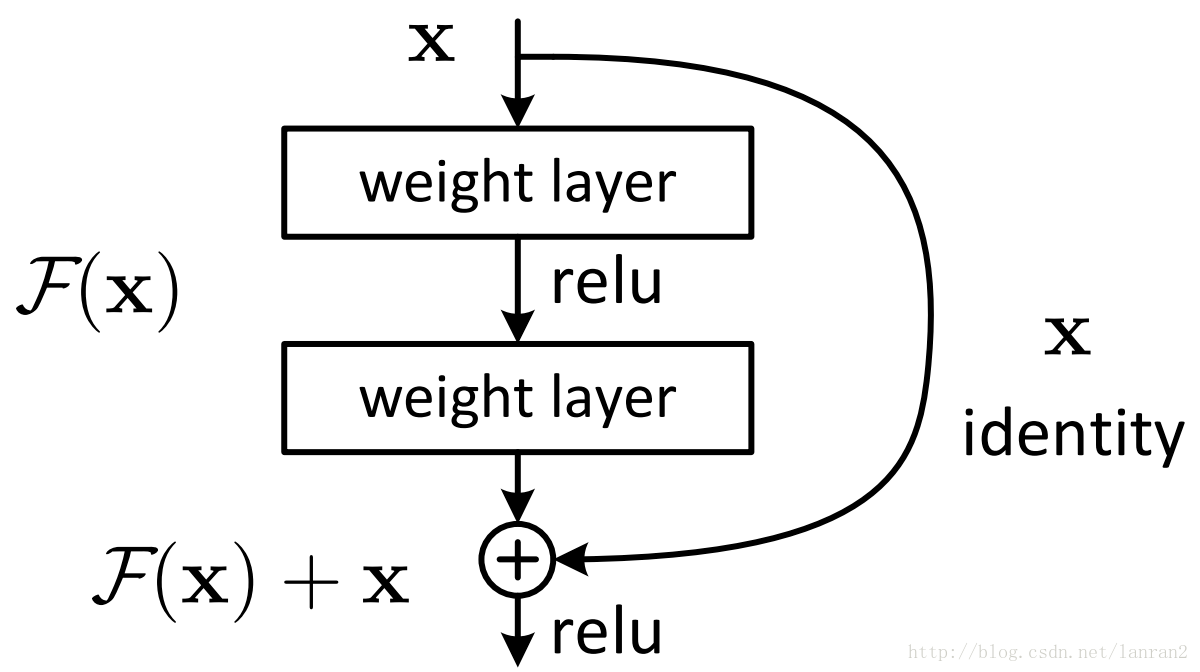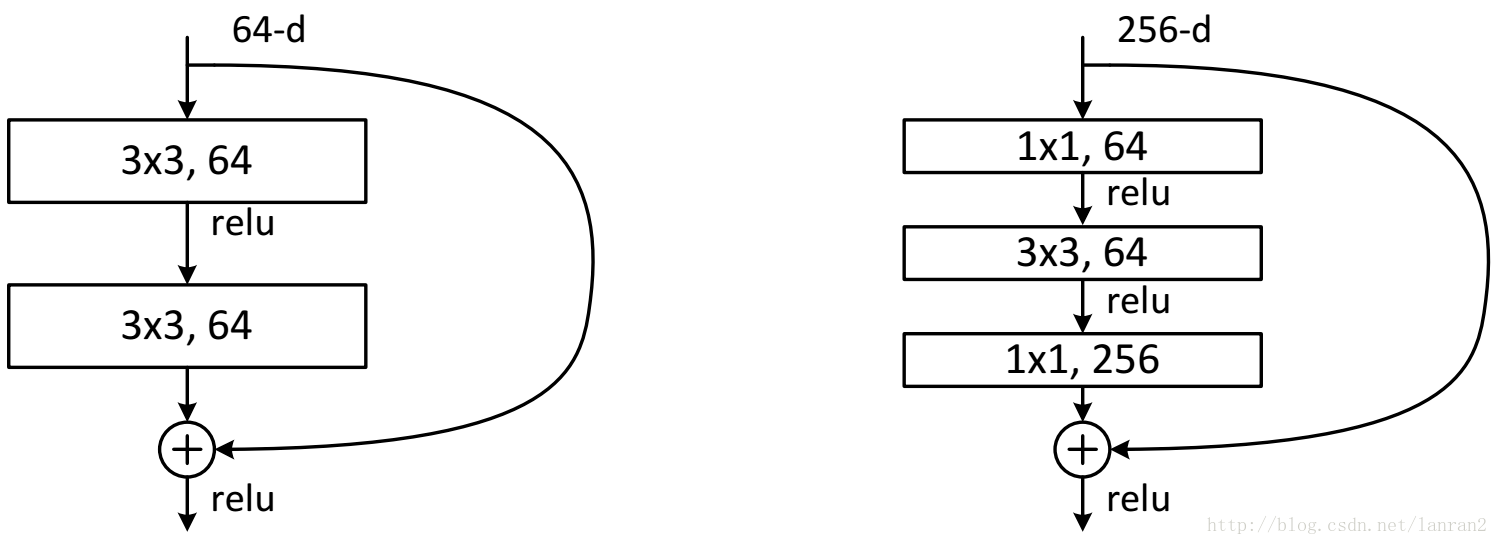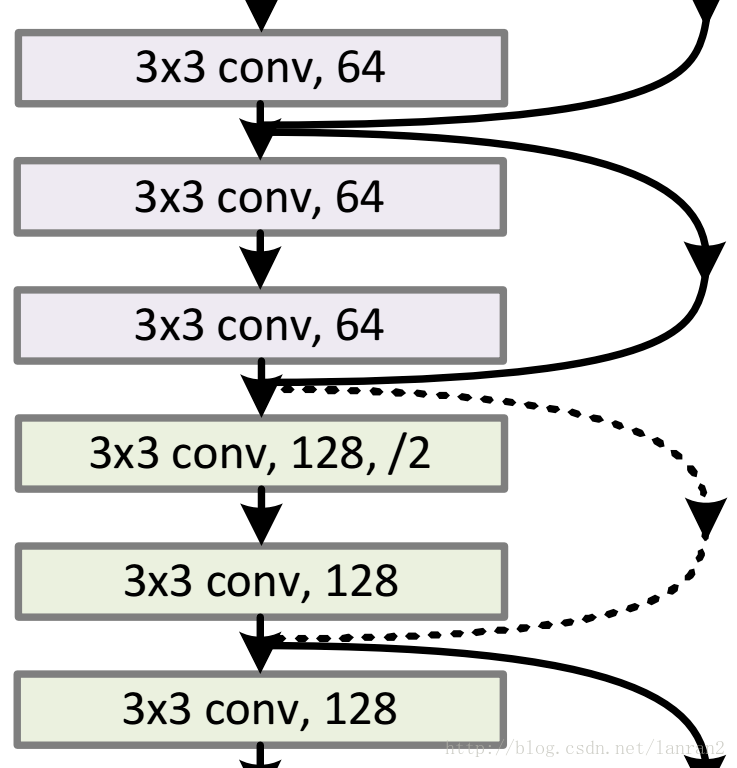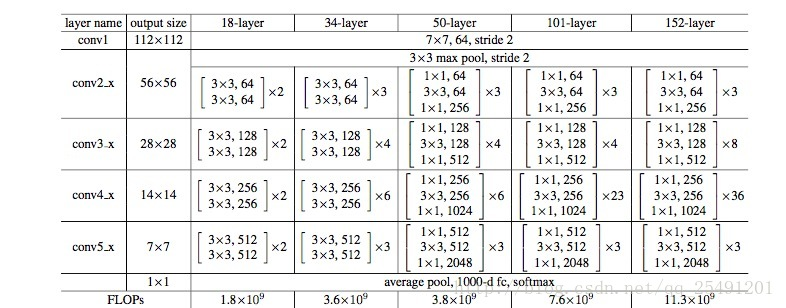ResNet在2015年被提出,在ImageNet比赛classification任务上获得第一名,因为它“简单与实用”并存,之后很多方法都建立在ResNet50或者ResNet101的基础上完成的,检测,分割,识别等领域都纷纷使用ResNet,Alpha zero也使用了ResNet,所以可见ResNet确实很好用。
Resnet网络的概览
1 为了解决训练很深的网络时候出现的梯度退化(gradient degradation)的问题,Kaiming He提出了Resnet结构。由于使用了残差学习的方法(Resuidal learning),使得网络的层数得到了大大的提升。
2 ResNet由于使用了shortcut,把原来需要学习逼近的未知函数H(x)恒等映射(Identity mapping),变成了逼近F(x)=H(x)-x的一个函数。作者认为这两种表达的效果相同,但是优化的难度却并不相同,作者假设F(x)的优化会比H(x)简单的多。这一想法也是源于图像处理中的残差向量编码,通过一个reformulation,将一个问题分解成多个尺度直接的残差问题,能够很好的起到优化训练的效果。
3 ResNet针对较深(层数大于等于50)的网络提出了BottleNeck的结构,这个结构可以减少运算的时间复杂度。
4 ResNet里存在两种shortcut,Identity shortcut & Projection shortcut。Identity shortcut使用零填充的方式保证其纬度不变,而Projection shortcut则具有下面的形式y=F(x,Wi)+Wsx来匹配纬度的变换。
5 ResNet这个模型在图像处理的相关任务中具有很好的泛化性,在2015年的ImageNet Recognization,ImageNet detection,ImageNet localization,COCO detection,COCO segmentation等等任务上取得第一的成绩。
1.ResNet意义
随着网络的加深,出现了训练集准确率下降的现象,我们可以确定这不是由于Overfit过拟合造成的(过拟合的情况训练集应该准确率很高);所以作者针对这个问题提出了一种全新的网络,叫深度残差网络,它允许网络尽可能的加深,其中引入了全新的结构如图1;
图1
为了解决梯度退化的问题,论文中提出了Residual learning这个方法,它通过构造一个Residual block来完成。引入残差结构以后,把原来需要学习逼近的未知函数H(x)恒等映射(Identity mapping),变成了逼近F(x)=H(x)-x的一个函数。作者认为这两种表达的效果相同,但是优化的难度却并不相同,作者假设F(x)的优化会比H(x)简单的多。这一想法也是源于图像处理中的残差向量编码,通过一个reformulation,将一个问题分解成多个尺度直接的残差问题,能够很好的起到优化训练的效果。上图的恒等映射,是把一个输入x和其堆叠了2次后的输出F(x)的进行元素级和作为总的输出。因此它没有增加网络的运算复杂度,而且这个操作很容易被现在的一些常用库执行(e.g.,Caffe,tensorflow)。
2 ResNet的构造

这两种结构分别针对ResNet34(左图)和ResNet50/101/152(右图),一般称整个结构为一个”building block“。其中右图又称为”bottleneck design”,目的一目了然,就是为了降低参数的数目,第一个1x1的卷积把256维channel降到64维,然后在最后通过1x1卷积恢复,整体上用的参数数目:1x1x256x64 + 3x3x64x64 + 1x1x64x256 = 69632,而不使用bottleneck的话就是两个3x3x256的卷积,参数数目: 3x3x256x256x2 = 1179648,差了16.94倍。
对于常规ResNet,可以用于34层或者更少的网络中,对于Bottleneck Design的ResNet通常用于更深的如101这样的网络中,目的是减少计算和参数量(实用目的)。
在针对F(x)与x的channel数的时候,要分为两种情况

如上图所示,我们可以清楚的”实线“和”虚线“两种连接方式,
实线的的Connection部分(”第一个粉色矩形和第三个粉色矩形“)都是执行3x3x64的卷积,他们的channel个数一致,所以采用计算方式:y=F(x)+x
虚线的的Connection部分(”第一个绿色矩形和第三个绿色矩形“)分别是3x3x64和3x3x128的卷积操作,他们的channel个数不同(64和128),所以采用计算方式:y=F(x)+Wx
其中W是卷积操作,用来调整x的channel维度的;
3 Resnet网络构建表

所有的网络都分成5部分,分别是:conv1,conv2_x,conv3_x,conv4_x,conv5_x
4 搭建ResNet
使用identity_block这个函数来搭建Resnet34,使用bottleneck这个函数来搭建Resnet50。
每个卷积层后都使用BatchNormalization,来防止模型过拟合,并且使输出满足高斯分布。
def Conv2d_BN(x, nb_filter, kernel_size, strides=(1, 1), padding='same', name=None):
if name is not None:
bn_name = name + '_bn'
conv_name = name + '_conv'
else:
bn_name = None
conv_name = None
x = Conv2D(nb_filter, kernel_size, padding=padding, strides=strides, activation='relu', name=conv_name)(x)
x = BatchNormalization(axis=3, name=bn_name)(x)
return x
def identity_Block(inpt, nb_filter, kernel_size, strides=(1, 1), with_conv_shortcut=False):
x = Conv2d_BN(inpt, nb_filter=nb_filter, kernel_size=kernel_size, strides=strides, padding='same')
x = Conv2d_BN(x, nb_filter=nb_filter, kernel_size=kernel_size, padding='same')
if with_conv_shortcut:
shortcut = Conv2d_BN(inpt, nb_filter=nb_filter, strides=strides, kernel_size=kernel_size)
x= add([x, shortcut])
return x
else:
x = add([x, inpt])
return x
def bottleneck_Block(inpt,nb_filters,strides=(1,1),with_conv_shortcut=False):
k1,k2,k3=nb_filters
x = Conv2d_BN(inpt, nb_filter=k1, kernel_size=1, strides=strides, padding='same')
x = Conv2d_BN(x, nb_filter=k2, kernel_size=3, padding='same')
x = Conv2d_BN(x, nb_filter=k3, kernel_size=1, padding='same')
if with_conv_shortcut:
shortcut = Conv2d_BN(inpt, nb_filter=k3, strides=strides, kernel_size=1)
x = add([x, shortcut])
return x
else:
x = add([x, inpt])
return x
def resnet_34(width,height,channel,classes):
inpt = Input(shape=(width, height, channel))
x = ZeroPadding2D((3, 3))(inpt)
#conv1
x = Conv2d_BN(x, nb_filter=64, kernel_size=(7, 7), strides=(2, 2), padding='valid')
x = MaxPooling2D(pool_size=(3, 3), strides=(2, 2), padding='same')(x)
#conv2_x
x = identity_Block(x, nb_filter=64, kernel_size=(3, 3))
x = identity_Block(x, nb_filter=64, kernel_size=(3, 3))
x = identity_Block(x, nb_filter=64, kernel_size=(3, 3))
#conv3_x
x = identity_Block(x, nb_filter=128, kernel_size=(3, 3), strides=(2, 2), with_conv_shortcut=True)
x = identity_Block(x, nb_filter=128, kernel_size=(3, 3))
x = identity_Block(x, nb_filter=128, kernel_size=(3, 3))
x = identity_Block(x, nb_filter=128, kernel_size=(3, 3))
#conv4_x
x = identity_Block(x, nb_filter=256, kernel_size=(3, 3), strides=(2, 2), with_conv_shortcut=True)
x = identity_Block(x, nb_filter=256, kernel_size=(3, 3))
x = identity_Block(x, nb_filter=256, kernel_size=(3, 3))
x = identity_Block(x, nb_filter=256, kernel_size=(3, 3))
x = identity_Block(x, nb_filter=256, kernel_size=(3, 3))
x = identity_Block(x, nb_filter=256, kernel_size=(3, 3))
#conv5_x
x = identity_Block(x, nb_filter=512, kernel_size=(3, 3), strides=(2, 2), with_conv_shortcut=True)
x = identity_Block(x, nb_filter=512, kernel_size=(3, 3))
x = identity_Block(x, nb_filter=512, kernel_size=(3, 3))
x = AveragePooling2D(pool_size=(7, 7))(x)
x = Flatten()(x)
x = Dense(classes, activation='softmax')(x)
model = Model(inputs=inpt, outputs=x)
return model
def resnet_50(width,height,channel,classes):
inpt = Input(shape=(width, height, channel))
x = ZeroPadding2D((3, 3))(inpt)
#conv1
x = Conv2d_BN(x, nb_filter=64, kernel_size=(7, 7), strides=(2, 2), padding='valid')
x = MaxPooling2D(pool_size=(3, 3), strides=(2, 2), padding='same')(x)
#conv2_x
x = bottleneck_Block(x, nb_filters=[64,64,256],strides=(1,1),with_conv_shortcut=True)
x = bottleneck_Block(x, nb_filters=[64,64,256])
x = bottleneck_Block(x, nb_filters=[64,64,256])
#conv3_x
x = bottleneck_Block(x, nb_filters=[128, 128, 512],strides=(2,2),with_conv_shortcut=True)
x = bottleneck_Block(x, nb_filters=[128, 128, 512])
x = bottleneck_Block(x, nb_filters=[128, 128, 512])
x = bottleneck_Block(x, nb_filters=[128, 128, 512])
#conv4_x
x = bottleneck_Block(x, nb_filters=[256, 256, 1024],strides=(2,2),with_conv_shortcut=True)
x = bottleneck_Block(x, nb_filters=[256, 256, 1024])
x = bottleneck_Block(x, nb_filters=[256, 256, 1024])
x = bottleneck_Block(x, nb_filters=[256, 256, 1024])
x = bottleneck_Block(x, nb_filters=[256, 256, 1024])
x = bottleneck_Block(x, nb_filters=[256, 256, 1024])
#conv5_x
x = bottleneck_Block(x, nb_filters=[512, 512, 2048], strides=(2, 2), with_conv_shortcut=True)
x = bottleneck_Block(x, nb_filters=[512, 512, 2048])
x = bottleneck_Block(x, nb_filters=[512, 512, 2048])
x = AveragePooling2D(pool_size=(7, 7))(x)
x = Flatten()(x)
x = Dense(classes, activation='softmax')(x)
model = Model(inputs=inpt, outputs=x)
return model为什么深度过深,训练的准确率降低,而且其不是过拟合?按照我们的惯性思维,一个网络越深则这个网络就应该具有更好的学习能力,而梯度退化是指下面一种现象:随着网络层数的增加,网络的效果先是变好到饱和,然后立即下降的一个现象。

参考博客:
https://blog.csdn.net/qq_25491201/article/details/78405549
https://blog.csdn.net/lanran2/article/details/79057994
最后
以上就是无奈芝麻最近收集整理的关于ResNet解析的全部内容,更多相关ResNet解析内容请搜索靠谱客的其他文章。








发表评论 取消回复